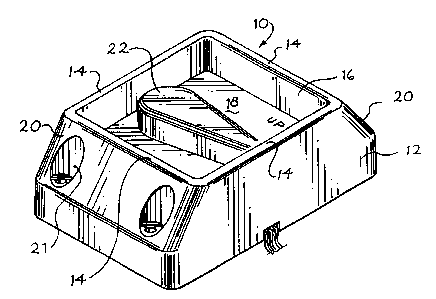Some of the information on this Web page has been provided by external sources. The Government of Canada is not responsible for the accuracy, reliability or currency of the information supplied by external sources. Users wishing to rely upon this information should consult directly with the source of the information. Content provided by external sources is not subject to official languages, privacy and accessibility requirements.
Any discrepancies in the text and image of the Claims and Abstract are due to differing posting times. Text of the Claims and Abstract are posted:
| (12) Patent: | (11) CA 2286228 |
|---|---|
| (54) English Title: | ELECTRICAL SWITCH |
| (54) French Title: | INTERRUPTEUR ELECTRIQUE |
| Status: | Expired and beyond the Period of Reversal |
| (51) International Patent Classification (IPC): |
|
|---|---|
| (72) Inventors : |
|
| (73) Owners : |
|
| (71) Applicants : |
|
| (74) Agent: | CASSAN MACLEAN |
| (74) Associate agent: | |
| (45) Issued: | 2003-04-22 |
| (86) PCT Filing Date: | 1999-02-26 |
| (87) Open to Public Inspection: | 1999-09-02 |
| Examination requested: | 1999-10-06 |
| Availability of licence: | N/A |
| Dedicated to the Public: | N/A |
| (25) Language of filing: | English |
| Patent Cooperation Treaty (PCT): | Yes |
|---|---|
| (86) PCT Filing Number: | PCT/US1999/004320 |
| (87) International Publication Number: | WO 1999044210 |
| (85) National Entry: | 1999-10-06 |
| (30) Application Priority Data: | ||||||
|---|---|---|---|---|---|---|
|
An electrical switch (10) includes a housing (12) having walls (14) extending
continuously around a recess (16). A switch actuator (22) is pivotally mounted
in the housing (12) in the recess (16) and protected by the walls (14). First
and second reed switches (30, 32) are mounted in the housing (10), and a
magnet (34) is mounted to the switch actuator (22) and is pivotable between a
first position, in which the magnet (34) activates the first reed switch (30),
and a second position, in which the magnet (34) activates the second reed
switch (32).
L'invention concerne un interrupteur électrique qui comprend un boîtier composé de parois s'étendant de manière continue autour d'un évidement. Un actionneur d'interrupteur est monté pivotant dans l'évidement situé dans le boîtier et protégé par les parois. Un premier et un second interrupteur à tiges sont montés dans le boîtier. Un aimant est monté sur l'actionneur d'interrupteur et peut pivoter entre une première position, dans laquelle l'aimant actionne le premier interrupteur à tiges, et une seconde position, dans laquelle l'aimant actionne le second interrupteur à tiges.
Note: Claims are shown in the official language in which they were submitted.
Note: Descriptions are shown in the official language in which they were submitted.

2024-08-01:As part of the Next Generation Patents (NGP) transition, the Canadian Patents Database (CPD) now contains a more detailed Event History, which replicates the Event Log of our new back-office solution.
Please note that "Inactive:" events refers to events no longer in use in our new back-office solution.
For a clearer understanding of the status of the application/patent presented on this page, the site Disclaimer , as well as the definitions for Patent , Event History , Maintenance Fee and Payment History should be consulted.
| Description | Date |
|---|---|
| Time Limit for Reversal Expired | 2014-02-26 |
| Letter Sent | 2013-02-26 |
| Inactive: IPC from MCD | 2006-03-12 |
| Inactive: Late MF processed | 2005-04-05 |
| Letter Sent | 2005-02-28 |
| Letter Sent | 2004-12-06 |
| Letter Sent | 2004-12-06 |
| Grant by Issuance | 2003-04-22 |
| Inactive: Cover page published | 2003-04-21 |
| Pre-grant | 2002-12-18 |
| Inactive: Final fee received | 2002-12-18 |
| Notice of Allowance is Issued | 2002-06-28 |
| Letter Sent | 2002-06-28 |
| Notice of Allowance is Issued | 2002-06-28 |
| Inactive: Approved for allowance (AFA) | 2002-06-14 |
| Amendment Received - Voluntary Amendment | 2002-05-08 |
| Inactive: S.30(2) Rules - Examiner requisition | 2002-01-25 |
| Letter Sent | 2001-03-13 |
| Reinstatement Requirements Deemed Compliant for All Abandonment Reasons | 2001-02-28 |
| Deemed Abandoned - Failure to Respond to Maintenance Fee Notice | 2001-02-26 |
| Inactive: Cover page published | 1999-11-29 |
| Inactive: IPC assigned | 1999-11-23 |
| Inactive: IPC assigned | 1999-11-23 |
| Inactive: First IPC assigned | 1999-11-23 |
| Inactive: Acknowledgment of national entry - RFE | 1999-11-10 |
| Letter Sent | 1999-11-10 |
| Application Received - PCT | 1999-11-08 |
| All Requirements for Examination Determined Compliant | 1999-10-06 |
| Request for Examination Requirements Determined Compliant | 1999-10-06 |
| Application Published (Open to Public Inspection) | 1999-09-02 |
| Abandonment Date | Reason | Reinstatement Date |
|---|---|---|
| 2001-02-26 |
The last payment was received on 2003-02-03
Note : If the full payment has not been received on or before the date indicated, a further fee may be required which may be one of the following
Please refer to the CIPO Patent Fees web page to see all current fee amounts.
Note: Records showing the ownership history in alphabetical order.
| Current Owners on Record |
|---|
| INTELLITEC PRODUCTS LLC |
| Past Owners on Record |
|---|
| WILLIAM H. SLAVIK |